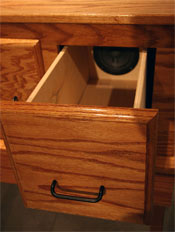



Cabinet (Applause Collection)
Observe this attentive face, these dilated nostrils, these quivering lips, this taut neck, these hands ready to come together - What fire! What heat! What impetuosity! The pleasure experienced and the emotion felt in common run like an electric current through the whole crowd. There is no touch of the dead hand in this public! - Emile Segaud, 1849
When Gustave Le Bon wrote of crowds at the end of the nineteenth century, many believed that an individual became an automaton when they got absorbed into the crowd. No longer in command of their own passions and actions, they became animated by the energy of the mob and were prone to irrational and destructive behavior. This magical power of the crowd was explained in terms of the cutting edge sciences of the day - electric currents connecting people, chemical reactions producing bizarre behavior in groups.
The most basic definition of a crowd is a group of things considered together. But what does it mean to be together? Sometimes, it's obvious - the throngs on a busy city street or the spectators in a stadium. But technological mediation makes the question a little more difficult. The audience of the Chinese version of American Idol numbered over 400 million. News websites recorded hundreds of millions of visits shortly after September 11, 2001. The question isn't just what does it mean to be together, but do we even know when we are together?
This installation is based on a research project in which I have been recording and archiving the applauses that I experience. These applauses are temporary moments when we leave our individual, isolated bodies and become a part of a collective body, with its own temperament and desires. Each of the five drawers in the cabinet contains a particular subset from the larger collection (for example, all of those applauses that are primarily ÔWoooooÕ). The cabinet itself is a homemade device that has been designed around its contents, much like a library's card catalog furniture is based on the dimensions of a single index card.
Accompanying the cabinet is a schema that introduces a system and vocabulary for the classification of applauses. It is inspired by the nineteenth century French criminologist Alphonse Bertillon's anthropometric system for identifying individuals. His system of bertillonage sought to exhaustively describe individuals in physical and contextual terms, demonstrating how no two people were identical. Ultimately, this detailed and labor-intensive process was rendered inefficient and obsolete by the emerging technique of fingerprinting. Juan Vucetich, the Croatian who immigrated to Argentina and introduced fingerprinting there, once described the cabinet that held the records as an organ. Regardless of their differences, each method was deeply integrated with its material articulation.
Crowds and applauses can be understood as living things, with agency, substance, and duration. They are the ground against which the figure of the individual is seen. This installation proposes a way of recognizing variation and uniqueness within the otherwise homogenous phenomenon of applause. But, rather than privileging mastery and identification, the cabinet encourages discovery and recombination, such that the applauses mix to produce new, potential forms of collectivity. At a time when dispersed, but connected networks are leaving the mark of nostalgia on those moments where people share the same time and space, Cabinet serves as a memorial to a passing era of crowds. It is a living memorial, however, that activates its subject and finds new possibilities in the obsolete.